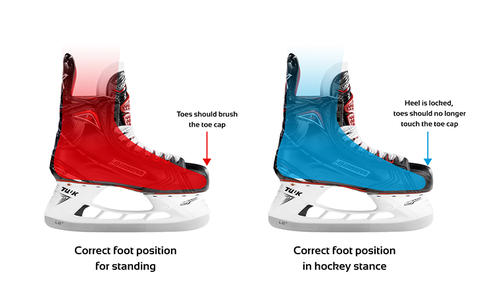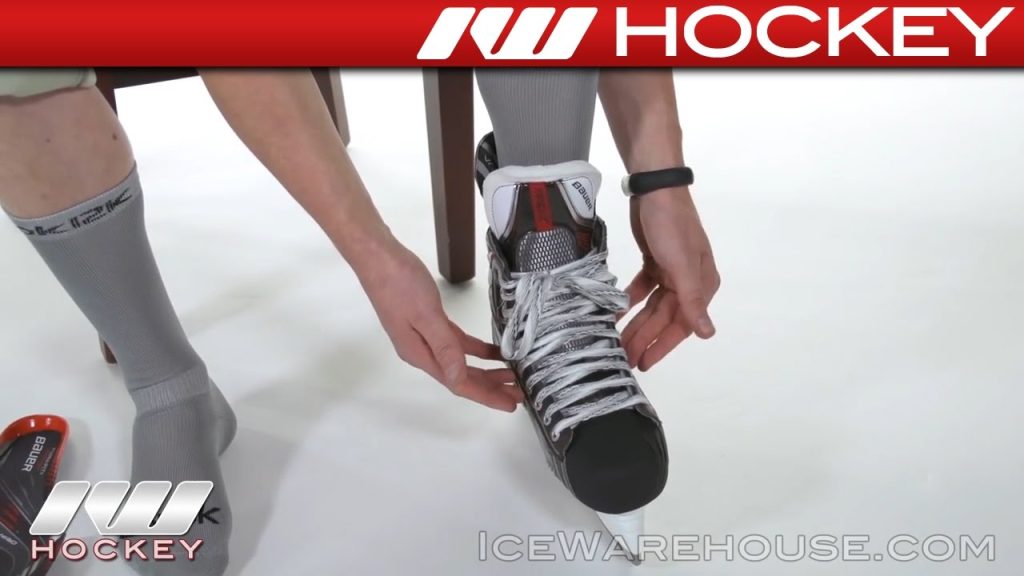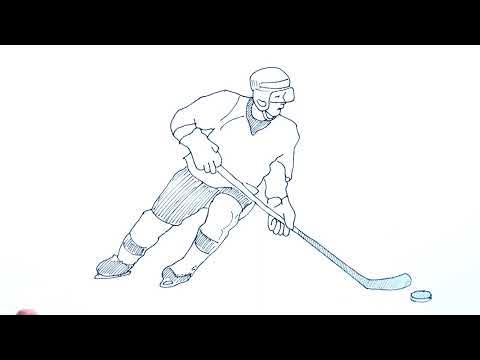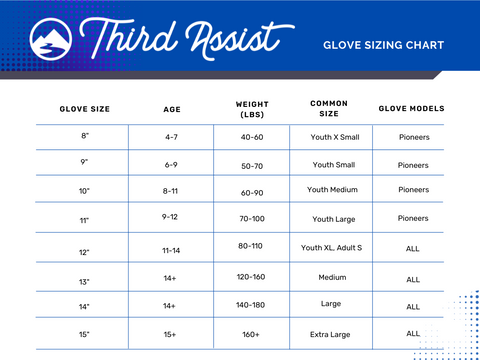Fitting ice hockey skates is crucial for comfort and performance. Properly fitted skates can enhance your game and prevent injuries.
Finding the right fit for ice hockey skates can be tricky. Skates that are too tight cause pain, while those too loose affect control. This guide will help you understand the steps to achieve the perfect fit. From measuring your feet to breaking in the skates, we’ll cover it all.
Ensuring your skates fit well will not only improve your on-ice performance but also increase your enjoyment of the game. Whether you’re new to ice hockey or looking to replace your old skates, this guide is here to help. Let’s get started on getting you fitted for the perfect pair of ice hockey skates!
Choosing The Right Skate
Selecting the perfect ice hockey skates can be overwhelming. With various options available, finding the right pair ensures comfort and performance. This guide will help you choose skates that fit well and meet your needs.
Types Of Skates
Ice hockey skates come in different types to suit various playstyles and experience levels. Here are the main types:
- Recreational Skates: Ideal for beginners and casual players. These skates offer basic support and are affordable.
- Performance Skates: Designed for intermediate players. They provide better support and enhanced features.
- Elite Skates: Made for advanced players. These skates offer maximum support, durability, and performance-enhancing features.
Size And Fit
Getting the right size and fit is crucial for comfort and performance. Follow these steps to find your perfect size:
- Measure your foot length in centimeters.
- Consult the skate brand’s size chart for accurate sizing.
- Try on the skates with your hockey socks.
- Ensure your toes lightly touch the toe cap.
- Check for a snug fit around the heel and ankle.
Remember, a tight fit prevents blisters and enhances control. Avoid skates that feel too tight or too loose.
| Feature | Description |
|---|---|
| Toe Fit | Your toes should lightly touch the toe cap. |
| Ankle Support | The skate should provide firm support without discomfort. |
| Heel Lock | The heel should stay in place without slipping. |
Choosing the right ice hockey skates involves understanding different types and ensuring a proper fit. Follow these guidelines to find skates that enhance your game and provide comfort.

Credit: www.hockeymonkey.com
Measuring Your Feet
Fitting ice hockey skates correctly is essential for comfort and performance. The first step is measuring your feet. Accurate measurements ensure the skates fit well. Let’s dive into the key aspects of measuring your feet.
Length And Width
Start by measuring the length and width of your feet. Use a tape measure or ruler for accuracy. Follow these steps:
- Place a piece of paper on a hard surface.
- Stand on the paper with your weight evenly distributed.
- Trace the outline of your foot with a pencil.
- Measure the length from the heel to the longest toe.
- Measure the width at the widest part of your foot.
It’s important to measure both feet, as they may differ in size. Use the larger measurement for the best fit.
Arch And Instep
Next, consider your arch and instep. These affect how the skates fit around your foot. Follow these steps:
- Wet the bottom of your foot.
- Step onto a piece of cardboard or paper.
- Observe the footprint that remains.
If you see a full footprint, you have a low arch. If the footprint is mostly the ball and heel, you have a high arch.
The instep is the top part of your foot. High insteps need more volume in the skate. Low insteps need less volume. Understanding your arch and instep helps choose skates with the right support.
Skate Baking Process
The skate baking process is essential for achieving a comfortable and customized fit for your ice hockey skates. This method, often referred to as heat molding, involves heating the skates to mold them to the shape of your feet. This ensures better support and enhances performance on the ice. Below, we delve into the benefits of heat molding and provide a step-by-step guide to help you through the process.
Heat Molding Benefits
Heat molding offers several benefits that improve the overall fit and feel of your skates. Firstly, it reduces the break-in period, allowing you to skate comfortably sooner. Secondly, it minimizes pressure points that can cause discomfort and blisters. Lastly, it enhances the overall support and stability of the skates, leading to better performance.
Step-by-step Guide
Follow this step-by-step guide to heat mold your ice hockey skates:
- Preheat your oven to 175°F (80°C). Make sure it’s not too hot.
- Remove any insoles or footbeds from your skates to avoid damage.
- Place your skates on a baking sheet and insert them into the oven.
- Heat the skates for about 5-7 minutes. They should be warm, not hot.
- Take the skates out of the oven carefully. They will be pliable.
- Put on a pair of thin socks and lace up the skates snugly.
- Sit down and keep your feet flat on the ground. Hold this position for about 15 minutes.
- Remove the skates and let them cool completely before using them.
By following these steps, you will achieve a custom fit that enhances comfort and performance.

Credit: www.youtube.com
Lacing Techniques
Lacing your ice hockey skates correctly is crucial for comfort and performance. The way you lace your skates affects your fit and support. Let’s explore some effective lacing techniques to help you get the best fit.
Standard Lacing
Standard lacing is the most common method. Start by threading the laces through the bottom eyelets. Pull them evenly to ensure both sides are equal. Cross the laces over each other and pull them through the next set of eyelets. Continue this pattern up the skate. Make sure each section is snug but not too tight. Standard lacing provides a uniform fit and is easy to adjust.
Alternative Methods
Alternative lacing methods can offer better comfort or support. One popular method is the “over-under” technique. Start by threading the laces through the bottom eyelets. Instead of crossing the laces over each other, thread them straight up to the next eyelet. Then cross them over and continue the pattern. This method can reduce pressure on certain areas.
Another method is the “lock lacing” technique. This helps prevent the laces from loosening. Lace the skates normally until you reach the last few eyelets. Then, instead of crossing the laces, loop them through the same side eyelet to create a lock. Pull the laces tight and tie them as usual. Lock lacing can provide a more secure fit for intense play.
Breaking In Your Skates
Breaking in your ice hockey skates is crucial. It ensures a comfortable fit and avoids injuries. New skates can be stiff and tight. They need to mold to your feet. Below are some tips to help you break in your skates.
Initial Usage
Wear your new skates around the house. This helps them start molding to your feet. Begin by putting on thick socks. Lace them up tightly, as you would for a game. Walk around for 10-15 minutes daily.
Another method is to use a skate oven. Many hockey shops have these. Heat your skates for a few minutes. Then, wear them until they cool. This speeds up the break-in process.
Common Issues
Breaking in skates can cause blisters or discomfort. Use gel pads or moleskin to protect sensitive areas. Make sure your skates are not too tight or too loose. Improper fit can cause pain and poor performance.
Another common issue is stiffness. If your skates feel too stiff, try loosening the top eyelets. This can provide more ankle flexibility. You can also try skating in them during practice. This allows your feet to adjust gradually.
| Issue | Solution |
|---|---|
| Blisters | Use gel pads or moleskin |
| Discomfort | Ensure proper fit, not too tight or loose |
| Stiffness | Loosen top eyelets, skate during practice |
Remember, breaking in your skates takes time. Be patient and follow these tips. Soon, your skates will feel like a second skin.
Comfort And Support
Fitting ice hockey skates is crucial for comfort and support. Skates that fit well can enhance your performance on the ice. They also prevent injuries and discomfort. Here, we’ll discuss key elements like padding, liners, and custom insoles.
Padding And Liners
Padding and liners are essential for a comfortable fit. They provide cushioning and reduce pressure points. Quality padding molds to your feet over time. This creates a custom fit that improves comfort. Liners wick away moisture, keeping your feet dry. Dry feet stay warm and prevent blisters.
Custom Insoles
Custom insoles offer extra support. They align with the natural shape of your feet. This reduces pain and improves balance. Off-the-shelf insoles may not fit perfectly. Custom options can be molded to your exact foot shape. This leads to better weight distribution and more comfort.
Maintenance And Care
Taking good care of your ice hockey skates is essential for their longevity and your performance on the ice. Regular maintenance ensures your skates remain in top condition. Below are some key points to consider.
Drying And Storage
Proper drying and storage are critical to maintaining your skates. After each use, follow these steps:
- Remove the insoles and laces to allow air circulation.
- Use a towel to dry the inside and outside of the skates.
- Leave the skates in a well-ventilated area to air dry completely.
Never leave skates in a damp bag or car trunk. This can cause rust and bacteria growth. Store skates in a cool, dry place. Use skate guards to protect the blades.
Blade Sharpening
Keeping your blades sharp is crucial for performance. Dull blades affect your ability to skate smoothly. Follow these guidelines:
- Check the blades for nicks and burrs regularly.
- Sharpen blades after 8-10 hours of ice time.
- Use a professional sharpening service if you’re unsure.
Proper sharpening involves maintaining the hollow radius of the blade. This ensures you get the best glide and control on the ice.

Credit: puckstop.com
Common Fitting Problems
Fitting ice hockey skates can be tricky. Many players face common fitting problems that affect their performance and comfort. Here, we will address two main issues: heel slippage and toe pain. Understanding and fixing these problems can help you enjoy a better skating experience.
Heel Slippage
Heel slippage occurs when your heel lifts inside the skate. This can cause blisters and reduce control. To prevent heel slippage, follow these tips:
- Proper Lacing: Ensure your skates are laced tightly, especially around the ankles.
- Heel Lock Lacing: Use a heel lock lacing technique for added security. Cross the laces over the top eyelets and pull tight.
- Custom Insoles: Consider using custom insoles for a better fit and more support.
- Breaking in: Wear your skates around the house to break them in. This helps the material mold to your feet.
Toe Pain Solutions
Toe pain is another common issue. This can be due to tightness or improper fit. To alleviate toe pain, try these solutions:
- Proper Sizing: Ensure your skates are the correct size. Your toes should just brush the front of the skate.
- Stretching: Use a skate stretcher to widen the toe box if needed.
- Padding: Add padding or gel inserts to reduce pressure on your toes.
- Heat Molding: Heat mold your skates at a professional shop. This can provide a more personalized fit.
By addressing these common fitting problems, you can improve your comfort and performance on the ice.
Frequently Asked Questions
How Do You Know If Ice Skates Fit?
To know if ice skates fit, ensure they are snug but not painful. Your toes should slightly touch the front without curling. There should be no heel lift when you skate.
How Tight Should Ice Hockey Skates Be?
Ice hockey skates should be tight enough to offer support but not cut off circulation. Your foot should feel snug, with no excessive movement.
What Is The Best Way To Break In Ice Skates?
The best way to break in ice skates is to wear them during practice sessions. Skating for short periods will help the skates mold to your feet.
How Do You Measure Your Foot For Skates?
To measure your foot for skates, place your foot on a piece of paper. Trace around it, then measure the longest and widest points.
Conclusion
Choosing the right ice hockey skates is crucial for comfort and performance. Make sure to measure your feet accurately. Try on different sizes and brands to find the best fit. Lace up your skates tightly but comfortably. Pay attention to how your feet feel during skating.
Proper fit helps prevent blisters and injuries. Take your time to find the perfect pair. Your skating experience will improve significantly. Enjoy the game with well-fitted skates!



